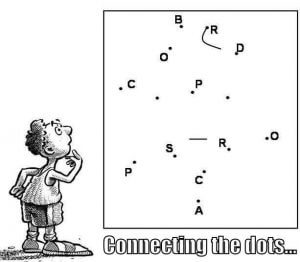 Connecting the dots… Cognitive performance… Cognitive activity… what am I talking about?
Connecting the dots… Cognitive performance… Cognitive activity… what am I talking about?
Cognition, according to the dictionary is “the mental action or process of acquiring knowledge and understanding through thought, experience, and the senses.” Acquiring knowledge means: it stays… NOT merely understanding. You’ll see why later in this article.
As clients get better results nowadays, I am now really motivated to get better myself, to be able to help them get even better results.
So I read more books, watch more relevant videos, have extra conversations to home in on what isn’t working as well yet as I hoped it would, and what would.
How do I learn?
Before I continue, let me share my learning style: I learn in tiny chunks… meaning: I don’t think filling myself up with stuff… is going to nourish me. It is as if I ate with a teaspoon… or chopsticks…
So I learn the way nature means for me to learn.
- If you eat more than your stomach can easily handle… it will lead to indigestion
- If you eat when the stomach is not ready to accept food… it will lead to indigestion
- If you eat but don’t chew… it will lead to undigested food in your gut
- If you eat something that you don’t have appetite for, your body will refuse to digest it fully.
I eat when I have an appetite. That is my eating style… I go to my fridge and look at or touch each of my choices. I have appetite, but not for anything that is in my fridge… So I go to my pantry… and look. For example, this morning I had appetite for pink salmon with curry powder… My stomach loved it, and it welcomed it.
Same with learning: I read what my brain says to read, I watch what my brain says to watch. And it also tells me when to stop… It got what it needed.
A principle is a principle because it is portable… it is true everywhere
In terms of learning… a principle is a principle because it is portable… it is true everywhere.
How much is the quantity that integrates with what the body can take? In food it is one fist size… in knowledge… a few bites at a time, not more.
Remember first grade? They didn’t attempt to teach you the whole alphabet in one sitting! No. they taught you one letter at a time, then they connected that one letter to words, to pictures… they were building the context, the connections.
Same with language learning. Helen Keller’s key was the word “water”… and it created the world of language for her. She became human in an instance.
So here is an example of my learning style: I watch my hero, Robert Plank program (code) a wordpress plugin on live video today. I was glued to the screen.
What was my context inside which I watched him for 90 minutes?
I am not a programmer, nor have I the ambition to become one. So I didn’t watch him to learn coding, or even to understand coding. But I am a student of what makes an expert, what makes a high achiever, and Robert is both.
I saw that when you have a substantial usable knowledge, you see and recognize things at a glance, things that would take me hours to see what is there. I have been Robert’s student for at least ten years… so he has put in his ten dark years, both in php programming and in marketing, doing live webinars and now live facebook gigs.
He is able to be light, not salesy, and most importantly for this post: connect the dots. Said in another way: he has dots to connect… you’ll understand what that means later in this article.
So back to how I learn: bite size, as I said. 10 minutes learning, a few hours of pondering, puzzling it out, connecting the dots. 10-20 times more time for the “digesting” than for the input.
I have heard somewhere that this is the healthy proportion of time to actually create knowledge, 1 to 10~20.
Just like with food… you eat for 5-10 minutes and digest it for a few hours, if it is protein, 6-7 hours.
If your style is input, input, more input… you’ll get indigestion=no digestion, you don’t turn the food into nutrition, you turn it into toxins.
I have been experimenting how much new information can be delivered in an hour, information that the “stomach” aka the brain of a student can take.
Trust me, I have so much knowledge, I can bury you under it… So I am learning to give less, and give it much slower, accompanied by a lot of stories, a lot of back and forth conversation.
If there is one thing you want to copy from me is this bite size eating and learning.
Now, what is this “connecting the dots” thing?
Once you actually get some learning: what you learn is always a principle or it wasn’t worth learning.
But learning the principle at one place, as if it belonged there, results in not real learning.
You know you have engaged in real learning if you can look at the world through the window the new principle opens up. And by the world I mean every area of life, where you have some knowledge.
The principles (and the distinctions), through the pondering process, will create a network of knowledge, where your learning one thing suddenly 10x because what you learned is true everywhere.
I carefully examine everything I learn to verify that it is in fact principles.
Here is an example: I read the book Blink that talks about the tipping point where a little breeze can push over big, seemingly immovable obstacles.
That book has a 10% truth value because more than one of those big blink events weren’t caused by the tipping point principle.
Just because something looks similar to something else, they aren’t the same. 1
And yet, the tipping point principle is valid, even if the examples in the book are bull.
Most everyone has read the story, Acres of Diamonds… But what is the principle there?
 Most everyone has heard the saying: it is darkest before the dawn…
Most everyone has heard the saying: it is darkest before the dawn…
But not many people know that the two stories are saying the same thing: you don’t know, you cannot know how long more it will take to hit paydirt, diamonds, or enlightenment.
You can’t. But you can suspect that when you reach the deepest doubt, something is happening in the invisible.
Almost every breakthrough was heralded by despair in my life. And almost every crash was heralded by celebration or bragging. It is the two sides of the same coin.
OK… I could list examples of connecting the dots forever… this is one of my main activities I do in my brain-gym.
On the outside it looks like I am playing Freecell, but that is the outside. Inside the wheels are turning, and the brain is busy looking for dots to connect.
When you do something… sorry, when I do something, I give it my full attention. I put all power in all action, like Wallace D. Wattles suggests, making all action a successful action. Every action. Rarely do I allow my mind to wonder, except when I play Freecell… The job of Freecell is to use my mind while the brain is doing real work. Without Freecell the mind would interfere in the thinking, just like yours does. How do I know? I have experimented with it, and just like your mind, mine is interested in taking over, and taking me to places I have no intention to go.
The mind is like an untrained dog on a leash… will pull you out of your path, out of where you want to go.
Sometimes it is restful to go with the dog… but mostly it wants to go to places where it can be afraid, where it can judge, where it can give me anxiety. So I am putting the dog to play Freecell while I am doing some work… for many hours a day.
The activity of thinking, looking for dots to connect, is also called Mental Simulation. It takes work to train the brain to hold more than one thing without dropping any… it is a lot like plate spinning, but in plate spinning you only pay attention to one plate at a time. In Mental Simulation all the plates need to be visible to you and you need to see them all… like a construct.
For those who have done the 67 steps… Tai’s demonstration of mental simulation is nowhere near what it really is… it is not a linear process. Not at all.
I can’t do it, unless my hands and my mind are busy doing something that doesn’t need my processing brain.
As an architect I saw that to walk through the building, use it, as if I were the intended user of it, living in it, or working in it, or a visitor to the museum, a worker there… I needed this skill.
There are “great” architect who never did this, could not do it, and their buildings are impossible to live in. They are, instead, monuments to the ego of the architect.
I look like a procrastinator, because until I see the whole “construct”, whether it’s a strategy, or a course, or a principle that is really true everywhere, I sit on it… until I can see it.
Here is an article on the topic. I read it up until he started to talk about Napoleon Hill… then I saw that in fact, this dude (the writer) doesn’t understand what he is talking about. His vibration is 170… and it seems that it is not enough. Why? Because under 200 vibration the ability to distinguish clearly between similar stuff is not quite there, and the saying applies: For you everything is the same as everything else… except that not always.
This, being able to do what Einstein calls “combinatory game” 2 is one of the benefits to raise your vibration. But you can practice connecting the dots on any vibration, your results, what you find, won’t be true most of the time.
If you watch Steve Jobs, what you’ll certainly miss is that he followed his curiosity… He had curiosity… which means he already had a knowledge base. Then he learned new things, did new things… and then… he connected the dots.
Steve Jobs strength was what I am talking about in this article: he could connect the dots, take principles from one area, where he first learned it, to other areas where it created innovation.
If you know Jay Abraham, his only claim to fame was connecting the dots… he was a true rainmaker for his clients… same with Frank Kern.
As you raise your vibration, your ability to see things for what they are, accurately, across a wide swath of life, increases.
It is a pleasure to witness.
One more thing: I learned it from the Curious book that I do this mental gymnastic, mental simulation, is done with my long term memory… not my short term memory.
Most people have hardly any long term memory established, because when they were little, they skated by on their “brilliance”.
Interesting to note, that the people who I personally know, who consider themselves brilliant, have an IQ of 100-105, not brilliant at all.
Really brilliant people, somehow, instinctively know that “skating” is a bad idea.
I am in the process of testing a few online programs that promise memory enhancement… I’ll let you know when I find something I find works.
Summary:
This article, I hope, has given you glimpses into the world of higher vibration people who can use more than 1% of their brain power… that is, 1%, that “brilliant” people use. “Smart” people, IQ under 100, use zero percent of their brain for real thinking.
This is the current state of humanity.
It is a matter of habits, it is a matter of training.
People pay more attention to their waistline, to their looks than they pay attention to their brain.
As Tai Lopez says: everybody would like to get a six-pack stomach… but what you need is a six-pack brain.
Unfortunately he is one of the “brilliant” people. So when you are practicing with his 67 steps, you need to take this into consideration… I help you with that.
To reiterate what happens if you cannot/don’t connect the dots:
your knowledge exist like independent islands with no connection… so you can never really see the big picture, or the connection between pieces of knowledge. You can’t connect the dots.
How long does it take to train yourself? Depending on your attitude, you’ll start seeing results after about a year. why so long? Mostly because you need to build those little islands with reading. If there are no islands of knowledge, there is nothing to connect… Duh.
Where do I do it?
This training is best done in the daily tasks in the Reclaim program, where you can choose what material to work with, the 67 steps, the Invisibles, the Science Of Getting Rich… plus reading a ton of books…
The best and richest is the 67 steps for this purpose…
If you are interested, get in touch. Sophie at yourvibration.com
PS: Skills
One of the reasons people have such a hard time moving from one job to another, from one vocation to another, is because they don’t know, that skills, like principles, are portable.
So they think they have no skills, or they think that their skills are attached to a job.
Once a person gets this, they just clicked the light on… and can now start their journey. Not get this… no journey, only fumbling or slow death.
